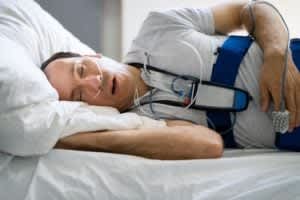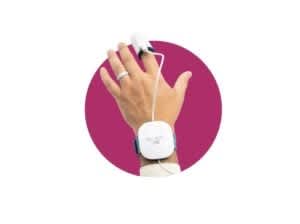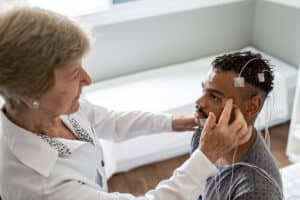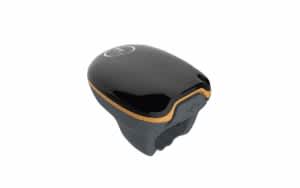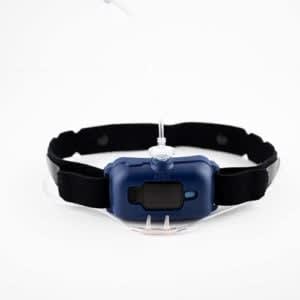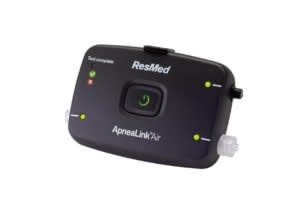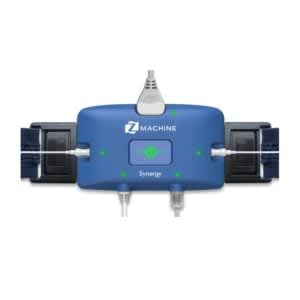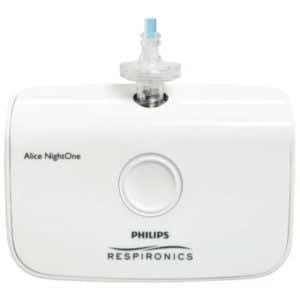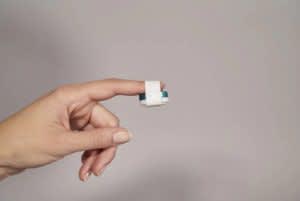Price:
$3,200When you buy through our links, we may earn a commission. Products or services may be offered by an affiliated entity. Learn more.
SleepView At-Home Review
The content on this page should not be taken as medical advice, nor do we claim this test reflects diagnosis. Always consult your doctor in regards to using this device and any test results it may indicate.
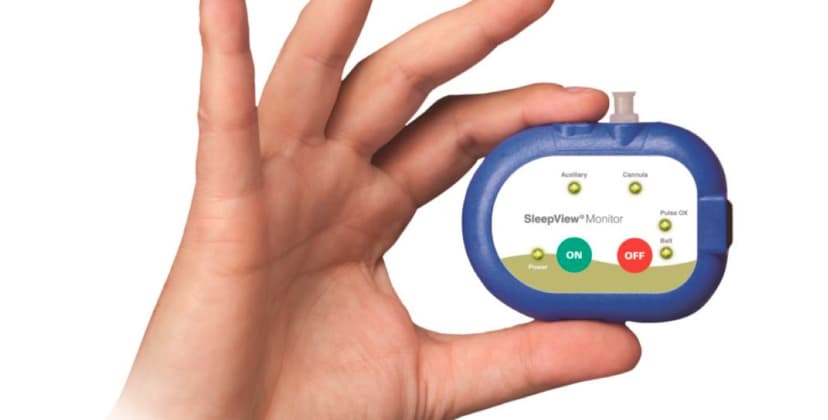
CleveMed SleepView

Sleep Foundation Special Offer
Use this SleepFoundation.org link for the most current discount on CleveMed products
The SleepView is an at-home sleep test manufactured by CleveMed, a medical device company. The test is a good option for individuals who need a test that gathers high-quality sleep data without having to spend a night in a sleep lab. This device has three wearable components that capture eight different data sets. The comprehensive information helps physicians determine whether an individual has sleep apnea.
The device is comfortable and easy to use. We’ll highlight what the device measures, how each component tracks data, and how the device can help health care professionals diagnose sleep apnea. We’ll also explore who this device is best for and who may want to consider an in-person sleep study instead.
What Is Obstructive Sleep Apnea (OSA)?
Obstructive sleep apnea (OSA) is a sleep condition that results in gasping or choking due to upper airway restriction. It’s most often caused when muscles surrounding the throat relax and block the breathing passage. OSA is a common disorder that affects between 10 and 30 percent of adults in the U.S.
Certain populations are more at-risk for developing OSA, including people with a high body mass index (BMI), men and people assigned male at birth, as well as those with above-average neck circumferences. You’re also more likely to develop OSA as you age. Untreated OSA can result in severe health problems such as cardiovascular disease, depression, diabetes, and drowsiness.
OSA is diagnosed in part by measuring your breathing patterns using a metric called the apnea-hypopnea index (AHI). Apnea refers to periods when your breathing stops or pauses, while hypopneas occur when your breathing is shallow. Doctors determine your AHI by finding the average number of hypopneas and apneas you experience during one hour of sleep. Your AHI score also indicates the severity of your OSA.
| AHI Score | Sleep Apnea Severity |
|---|---|
| 5-15 | Mild OSA |
| 15-30 | Moderate OSA |
| 30 or higher | Severe OSA |
Many people with OSA have symptoms like excessive tiredness, irritability, dry mouth, morning headaches, and loud, frequent snoring. If you regularly experience any of these symptoms or have had a partner mention that your breathing is often interrupted while you’re asleep, it may be worthwhile to do a sleep study.
How Does the CleveMed SleepView Work?
The SleepView at-home test helps doctors diagnose OSA by providing in-depth data through eight different channels. The device tracks the following metrics to detect sleep apnea.
- Heart rate: The pulse oximeter on your finger monitors your heart rate, reporting any fluctuations that correspond with your breath. This data can help your physician determine how strenuous it is for you to breathe.
- Pulse oximetry: In addition to your heart rate, the pulse oximeter also measures your blood oxygen level. Repeated hypopneas and apneas cause blood oxygen levels to decrease, and low blood oxygen levels can worsen sleep apnea symptoms.
- Respiratory airflow (compatible with CPAP): The nasal cannula tracks your inhalation and exhalation frequency and air pressure to determine irregularities in your breathing patterns. This measurement helps detect apneas and hypopneas. It’s also compatible for use with a continuous positive airway pressure (CPAP) machine, which is helpful for tracking respiratory airflow during therapy.
- Respiratory inductance plethysmography (RIP): The effort belt tracks chest movement to measure differences in lung volume that occur with each breath. RIP is an effective method for evaluating respiration quality and quantity.
- Body position: The device stores information regarding your sleeping position. This helps physicians see how your breathing changes as you shift body positions. The device can recognize when a person is supine, prone, upright, or on their left or right side.
- Snoring: The nasal cannula detects snoring, which can be helpful for your health care team. Loud and frequent snoring is a sleep apnea symptom for many people.
- Auxiliary: Physicians who purchase the SleepView can opt to buy several auxiliary components. These include a second RIP belt, a thermistor airflow sensor, and a proprietary IDcheck system that helps ensure patient authenticity.
- Integrated actigraphy: This feature checks whether the user is asleep or awake by monitoring their body movements.
On their own, each of these data sets are helpful in pointing towards an OSA diagnosis. Together, they provide doctors with valuable information that can detect both the presence and severity of sleep apnea. It’s important that the device captures detailed information from each of these channels, so users should ensure that all wearable components are correctly fastened before beginning their sleep study.
Getting a complete picture of your sleep health requires you to use the device correctly and follow the appropriate steps before and after your at-home sleep test.
- Step 1: Currently, the SleepView is only available for health care providers to purchase. If you’d like to use this at-home test, you’ll need to find a physician or sleep center that offers it. Most health care teams will send you the device as a rental that you mail back after you complete the test.
- Step 2: Once you’ve contacted a sleep specialist, they’ll send you the device along with instructions specific to your individual needs and their health care practice. Perform the study according to the directions, then check to see if the device recorded the necessary data. The sensor light will turn green if the study was sufficient, and it will turn red if it failed to collect the necessary data. Speak with your physician if another test is required and ensure each component fits correctly before attempting a second at-home test.
- Step 3: Mail back the device and await results from your doctor. Health care providers can access your data on cloud-based software through a secure web portal.
- Step 4: Your doctor will review your data to determine your AHI and develop a treatment plan if necessary. If you’re diagnosed with OSA, you’ll need a prescription to begin CPAP therapy. You may also need to complete a titration test so that your physician can determine the appropriate pressure settings for your individual needs.
How Do You Set Up and Use the CleveMed SleepView?
The CleveMed SleepView is easy to use at home, and each test includes straightforward instructions. The at-home test is a wearable device that includes an effort belt that wraps around the chest, a nasal cannula, and pulse oximeter that fits over the finger. Together, these three components measure eight different metrics that help doctors detect the presence of OSA.
- First, wrap the effort belt over the center of your chest. People with breasts can place the belt above or below them. Wear a loose-fitting shirt beneath the belt and use the velcro adjustment to get a snug fit. The monitoring device should be centered on your chest.
- Next, insert the nasal cannula into your nostrils and pull the connected tubing behind both ears. Tighten the tubes with the slide below your chin and secure the cannula to your face using medical tape. Connect the cannula to the device on your chest.
- Plug the pulse oximeter into the monitoring device and place the sensor over your index finger. Ensure that any nail polish is completely removed. Tape the cord to your hand and run it under your shirt if necessary.
- Press the “on” button and check the device’s lights. Green indicates a good connection, amber means you should check the corresponding sensor’s fit, and red alerts you that the sensor connection cord is not properly fastened. Once all the lights are green, you can go to sleep. CleveMed notes that you should try to sleep on your back for at least some of the night.
- When you wake up, turn the device off and check the lights. If the lights circle green in a clockwise direction, the study was successful. If they move counterclockwise in red, you’ll need to contact your health care provider to set up another test.
While you sleep, the SleepView device records each data point that it tracks and stores the information within the device. As long as all the components stay correctly attached, you should only need to wear the device for one night.
If the monitor did not record enough data or if any of the sensors detached during the night, you will need to contact your physician for further instruction on how to set up a second test. The device is capable of administering multiple tests, and accompanying software allows your doctor to view your sleep data through a secure web portal.
Who Should Use the CleveMed SleepView?
The CleveMed SleepView is approved by the U.S. Food and Drug Administration (FDA) and is a great choice for people looking for an affordable alternative to a traditional sleep study. Though the exact cost will vary depending on your health care provider, at-home sleep tests generally cost significantly less than in-person lab tests.
Some people may find an at-home test much more convenient than an in-person test. At-home tests only have three pieces, while traditional sleep studies require additional components. For certain people who may have OSA, it may also be easier to get high-quality data at home, as many find it difficult to get a full night’s rest in a sleep lab.
There are a few different types of people who may find this at-home test an excellent option.
- Value seekers: This test is likely to be more affordable than an in-person sleep study.
- People who can’t sleep well outside their homes: You can complete this test in your own bedroom. For those who might have a tough time sleeping in a lab, the SleepView is a suitable alternative.
- Frequent travelers: The test is also a great choice for people who travel often. Users have the option to complete the test when and where it is convenient for them rather than coordinating with a clinic, which can have long waitlists.
- Health care providers looking for a full-service at-home sleep study: CleveMed has several options for sleep specialists who want to offer patients at-home sleep tests. Health care providers can purchase the device outright and manage patient studies on their own or use CleveMed’s full-service plan that includes assistance with logistics and mailing.
- Those comfortable locating a sleep specialist who uses this device: This sleep test is not available for individuals to purchase. To use the SleepView, you will need to find a provider that offers this specific test.
Since this test is only available through health care providers, shoppers looking to purchase a test directly should consider other options. The SleepView is also not designed to diagnose any disorders other than OSA.
Pros and Cons of the CleveMed SleepView
The SleepView has a few distinct advantages for people looking for an at-home sleep test.
- User-friendly interface: The device is easy to set up, and the sensors make it easy to tell whether the study recorded enough data.
- Comprehensive software for physicians: Health care providers who use this device get access to secure, cloud-based software that makes it easy to share sleep data and test results with patients.
- Advanced diagnostics: The SleepView goes well beyond the three diagnostic measurements that the American Academy of Sleep Medicine (AASM) requires for at-home sleep tests. Physicians receive much more comprehensive patient data with the SleepView than they would with a more basic test.
However, this device does have a few drawbacks that are worth considering before purchasing.
- Availability: Only health care providers can purchase this device. Shoppers who are interested in the at-home study will need to locate a sleep specialist.
- Not adequate for certain professions: Some careers require regular health screens to maintain licensing requirements. The SleepView is a type 3 test, which doesn’t record as much specific health data as type 1 and 2 tests. Certain professionals may have to complete an in-person study to comply with state or federal licensing requirements.
- Follow-up required: Though the SleepView lets you skip going to a sleep lab for an OSA diagnosis, you’ll still likely have to visit the doctor to get a CPAP prescription or a titration test.
Cost, Shipping, and Returns
Since the device is only available to medical professionals, cost and insurance coverage for the SleepView depend on your individual health care provider. Generally, at-home sleep tests are less expensive than in-person tests, so this device may be a good option if your deductible is high or if your insurance isn’t likely to cover an in-person study. Individuals are not able to buy the device outright, as it’s meant for health care providers to use with multiple patients.
Shipping specifics, device rentals, and logistics will vary depending on what your physician directs. However, the device makes data retrieval simple and is designed to help doctors provide individuals with quick and accurate sleep information. Typically, at-home sleep tests don’t require a prescription or referral, but you’ll need a prescription for any type of OSA treatment following a diagnosis.
Physicians looking to purchase this at-home test for patient use can contact CleveMed directly on the company’s website. The device includes a one-year warranty.
The Bottom Line
The CleveMed SleepView is an excellent choice for health care providers who want a user-friendly at-home sleep test that doesn’t sacrifice data for simplicity. It captures significantly more information than many other at-home tests, and its physician-facing data tools are comprehensive and secure. More than one person can use the device, and doctors can purchase single-use cannulas and effort belts in bulk from CleveMed.
People who suspect they have OSA will need to find a physician who carries the SleepView to complete the test. Shoppers can’t purchase the test on their own, and finding a provider who offers this device may be too time-consuming for some people. However, if the SleepView sounds like the best fit for your needs, the advanced diagnostics make it a good alternative to a traditional sleep study for those willing to locate a provider.

Still have questions?
Our product experts have extensive experience testing just about every sleep product on the market. Send an email to [email protected] or call us at (877) 672-8966 with your questions and we’ll help you find exactly what you’re looking for.

